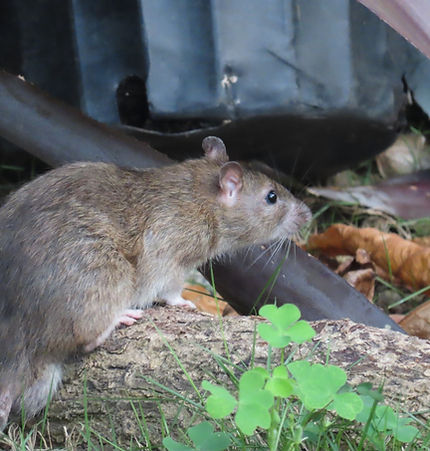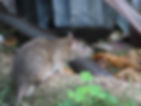
Furry Invasion
For thousands of years, humans have translocated hundreds of species of plants and animals around the world. While many are not recorded as being problematic, some species are. As a biodiversity hotspot, the West Indies is home to a wide variety of unique plants and animals. With regards to mammals, the West Indies is home to 60- 73 species, most of which are bats (Family Chiroptera) and rodents (Family Rodentia). Native members of the rodent family include hutias, rice rats, and West Indian Spiny Rats. The introduction of new mammals to the West Indies started with the Native Americans. During the Late Ceramic Age (600-1500 AD), guinea pigs were introduced into the West Indies, with the earliest recordings being from Puerto Rico. Native Americans also brought dogs to the region during this time. With the arrival of European explorers into the region, other species of mammals have been introduced and have transformed West Indian ecosystems and have led to the extinction of several native animals. Since the 1500’s, 22 species of West Indian land mammals have gone extinct, and when looked at globally, about 38% of all extinctions have been in the West Indies.
When Europeans came to The Bahamas starting in the late 1400s, they bought with them pigs, sheep, goats, cats, mice, rats, and dogs. Other intentional mammal introductions into The Bahamas include the Raccoon and the Virginia Opossum. Rats and mice were unintentionally introduced into the country, most likely as stowaways on ships. Most of these animals have wide distributions across The Bahamas. The Virginia Opossum has only been recorded from a Cay in the Exuma archipelago. Let’s talk about some of them.
The Northern Raccoon
The Northern Raccoon is a small omnivore that originated in North America. It was introduced into The Bahamas, starting with New Providence in the 1700s and Grand Bahama in the 1930s. They were then introduced to Abaco and then Eleuthera. Raccoons are opportunistic in their feeding habits and will eat human refuse, birds eggs, chicks, small reptiles, fruit and invertebrates. A raccoon was responsible for the deaths of 95- 363 San Salvador Rock Iguanas in a single year! Raccoons spread diseases like Canine Distemper, Leptospirosis, Rabies and the roundworm Baylisascaris procyonis.

Northern Raccoon
House Cat
It should come as no surprise that the House cat is one of the most invasive animals in The Bahamas. One of the reasons why this invasive animal has become so successful is because of its attractiveness. People love cats because they are small, furry, “cute” animals (especially kittens). Unfortunately, behind that attractive facade is a skillful and opportunistic predator that will instinctively hunt animals even when it is not hungry. In one study looking at feral cat populations living on islands, researchers found that over 248 species of animals were preyed on.

House Cat with freshly killed bird
House Cats are also responsible for the extinction of 16 animals on 120 islands, and led to 128 species becoming endangered. However, it is not just the outright killing of native animals that is the problem. House Cats and feral cats (House Cats that went wild) can also spread zoonotic diseases like toxoplasmosis. Feral cat populations on islands such as Great Abaco, had a serious negative effect on the Abaco Parrot, an endemic species/subspecies. Thanks to active conservation work done by The Bahamas National Trust and the removal of feral cats from Abaco National Park, the Abaco Parrot population saw a nearly 60% increase in its numbers.

Brown Rat
Rats and Mice
Rats and mice are some of the most well-known invasive animals. Originally from Asia and the Indo-Malayan region, the Brown and Black Rat now occupies over 80% of islands worldwide. Rats came to The Bahamas unintentionally as stowaways on European ships starting in the late 1400s. These invasive animals are huge agricultural, residential and ecosystem pests. They consume a variety of animals including seabird eggs and young, arthropods, and small vertebrates. They are prolific breeders with females coming into heat every 4-5 days and can come back into heat just 48 hours after giving birth! A rats gestation period is only 21-23 days and they can give birth from 5 to 13 pups. A Black rat can reach sexual maturity in just three months.
Rats are known to carry a host of diseases such as leptospirosis, toxoplasmosis, and rat lung worm.
Mice are smaller than rats and have been documented on 45 islands in the West Indies. They were first recorded in the West Indies before 1654. Although not as easily spotted as rats due to their small size, mice can be found in both urban and natural environments, feeding on fruits and seeds. Like the Black Rat, the House Mouse is a vector to zoonotic diseases such as Leptospirosis, Human hymenolepiasis and Trypanosoma cruzi- the parasite that leads to Chagas Disease.


fact sheets

COMING SOON!

COMING SOON!

COMING SOON!

COMING SOON!


posters

COMING SOON!

COMING SOON!

COMING SOON!

COMING SOON!


photo gallery


resources
Aplin, K.P., Suzuki, H., Chinen, A.A., Chesser, R.T., Ten Have, J., Donnellan, S.C., Austin, J., Frost, A., Gonzalez, J.P., Herbreteau, V. and Catzeflis, F., 2011. Multiple geographic origins of commensalism and complex dispersal history of black rats. PloS one, 6(11), p.e26357.
Awoniyi, A.M., Thompson, A., Ferguson, L., Mckenzie, M., Souza, F.N., Zeppelini, C.G. and Costa, F., 2021. Effect of chemical and sanitary intervention on rat sightings in urban communities of New Providence, the Bahamas. SN Applied Sciences, 3, pp.1-6.
Borroto-Páez, R. and Woods, C.A., 2012. Status and impact of introduced mammals in the West Indies. Terr. Mamm. West Indies Contrib, pp.241-257.
Dias, R.A., Abrahão, C.R., Micheletti, T., Mangini, P.R., de Oliveira Gasparotto, V.P., de Jesus Pena, H.F., Ferreira, F., Russell, J.C. and Silva, J.C.R., 2017. Prospects for domestic and feral cat management on an inhabited tropical island. Biological Invasions, 19, pp.2339-2353.
Hayes, W.K., Carter, R.L., Cyril Jr, S. and Thornton, B., 2004. Conservation of an endangered Bahamian rock iguana, I. Iguanas: biology and conservation, pp.232-257.
Helgen, K.M., Maldonado, J.E., Wilson, D.E. and Buckner, S.D., 2008. Molecular confirmation of the origin and invasive status of West Indian raccoons. Journal of Mammalogy, 89(2), pp.282-291.
Kemp, M.E., Mychajliw, A.M., Wadman, J. and Goldberg, A., 2020. 7000 years of turnover: historical contingency and human niche construction shape the Caribbean's Anthropocene biota. Proceedings of the Royal Society B, 287(1927), p.20200447.
Louppe, V., Baron, J., Pons, J.M. and Veron, G., 2020. New insights on the geographical origins of the Caribbean raccoons. Journal of Zoological Systematics and Evolutionary Research, 58(4), pp.1303-1322.
Medina, F.M., Bonnaud, E., Vidal, E. and Nogales, M., 2014. Underlying impacts of invasive cats on islands: not only a question of predation. Biodiversity and Conservation, 23, pp.327-342.
Panti-May, J.A., De Andrade, R.R.C., Gurubel-González, Y., Palomo-Arjona, E., Sodá-Tamayo, L., Meza-Sulú, J., Ramírez-Sierra, M., Dumonteil, E., Vidal-Martínez, V.M., Machaín-Williams, C. and De Oliveira, D., 2017. A survey of zoonotic pathogens carried by house mouse and black rat populations in Yucatan, Mexico. Epidemiology & Infection, 145(11), pp.2287-2295.
Shiels, A.B. and Ramirez de Arellano, G.E., 2018. Invasive rats (Rattus sp.), but not always mice (Mus musculus), are ubiquitous at all elevations and habitats within the Caribbean National Forest, Puerto Rico.





